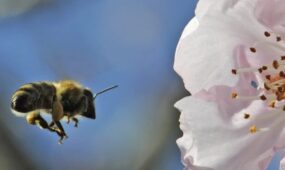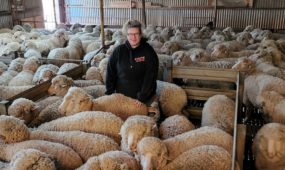Pomegranate push prepares to bear fruit Down Under
Primary Industries
A SUSTAINABLE farming company is building one of the world’s largest privately-owned pomegranate gene banks to help revive the potentially lucrative industry Down Under.

Sign up to receive notifications about new stories in this category.
Thank you for subscribing to story notifications.
Group Kinetica, based in Adelaide, South Australia, has launched PomPersia and has seven pomegranate test farms around Australia, including a gene bank in South Australia. It aims to expand to become a conglomerate of 200 growers by 2025.
Demand for pomegranates globally has spiked in recent years as health experts promote the “super fruit’s” anti-oxidant, anti-carcinogenic and anti-inflammatory properties.
At the same time, Australia’s fledgling industry has taken a hit from a mystery dieback condition, which has devastated many farms, including some of the industry’s biggest players.
Global production of the ancient fruit is about 4 million tonnes a year with major producers being Iran, India, China, Turkey and the United States. Less than 2 per cent of the world’s supply is grown in the southern hemisphere, mainly in South America. Australia produces about 4000 tonnes a year or 0.1 of 1 per cent of the global market.
Group Kinetica and PomPersia founder Omid Rad has spent seven years importing Pomegranate plants mainly from Iran and has developed a gene bank of 307 varieties at a test farm in South Australia’s Adelaide Hills run by Patrick Ryan.
The trees are being propagated and tested for regional suitability at seven farms in South Australia, Queensland, New South Wales and the Northern Territory.
Rad hopes to establish 12 regions across Australia with about 12 varieties available to farmers in each region.
“Then you work to hybridise to create the best fruit with the right size, the right shape and the best flavour,” he said.
Rad said ensuring varieties were well matched to growing conditions would lead to high yields and healthy trees.
He said keeping each farm small, 5ha to 15ha planted out at the rate of 948 trees per hectare, would help keep labour costs down and enabled farmers in each region to help each other.
Under the PomPersia model, trees and expert advice are provided for free in exchange for royalties when commercial fruit is produced. Trees take three years to begin producing fruit and reach peak production after five or six years.
“The biggest problem we have in Australia is manpower at a reasonable rate – so we back small farmers,” Rad said.
“We don’t want them to grow 500ha, we want them to grow 15ha masterfully without the need for hiring transient labour.
“The idea is there would be enough farms near him to make it possible for five farming families to focus their picking on Patrick’s farm this weekend, Tom and Jerry’s farm next weekend and so on.
“What Patrick has learnt will never escape him but transient labour will. If we do this and instead of having one farm of 200ha, have 40 farms of 5ha each then I think the success rate will be drastically improved.”
Almost 40 trial varieties will be planted at a new farm in South Australia’s Riverland – Australia’s largest wine region – in January 2017.
Rad said wine and citrus growing regions were ideal targets for pomegranate farms because they already had infrastructure, including irrigation, in place and they offered a viable alternative for growers struggling to make a profit in the saturated wine grape industry.
He said he wanted to partner with governments and industry to help growers shift resources from loss-making ventures into profitable ones such as pomegranates.
“The three South Australian regions we’re focusing on are Riverland, Adelaide Hills and Clare Valley and I’d like to think we can have 50 farms producing pomegranates in those three regions within 10 years,” he said.
“The exact same thing can be replicated in Victoria, New South Wales and Queensland. I’d like to think PomPersia will be a conglomerate of 200 growers by 2025 at various stages of commercial production.
“For the first three years we had only one farm. In the last 12 months we have added four and in the next 12 months I believe we will have 10 more. It’s gaining momentum but we need to grow ourselves before we can help others grow.”
Demand for pomegranates domestically is on the rise, providing Australian growers an opportunity to produce fruit for the local market and reduce the reliance on imports.
The southern hemisphere picking season runs from about February to May opposed to the September to November harvest in the northern hemisphere.
Rad said this provided a “golden opportunity” for high quality Australian fruit to be exported, particularly to Asia.
“Korea and Japan are markets we should be tapping into – South Korea gets the bulk of their pomegranates from Iran and California,” he said.
“Off-season they don’t eat it but they want it.
“Europe gets its off-season pomegranates from Peru and Chile but there’s no reason that couldn’t be us.”
PomLife is Australia’s largest pomegranate grower with about 80,000 trees over 110ha. The Victorian company produced 1500 tonnes last harvest, about half of the nation’s commercial crop in 2016, but has the potential to reach about 3500 tonnes in coming harvests.
PomLife fruit is sold fresh, as pure pomegranate juice and also sold as value added products such as fresh aril punnets and powder.
Australia is a net importer of pomegranates, bringing in almost as much as it produces every year from California in the off-season.
PomLife General Manager Joshua Reuveni said growing high quality pomegranates in Australia and working out effective storage methods was a real challenge.
He said while exporting fruit in the off-season might seem like a good opportunity, cheap pomegranates flooding Asian markets from South America made it unrealistic.
While there was some room for growth in the immature Australian market, Reuveni said any new fruit would need to be of premium quality to be viable.
“We get quite a lot of phone calls from farmers looking for advice so it is growing slowly,” he said.
“We welcome new growers because there is room for co-operation but it is very delicate because there is still a lot of education to do and it will take a lot of time for the fruit to become a household item in Australia.”
Jump to next article



